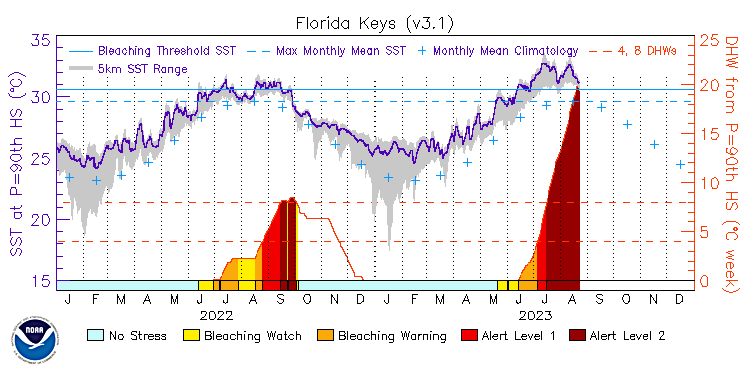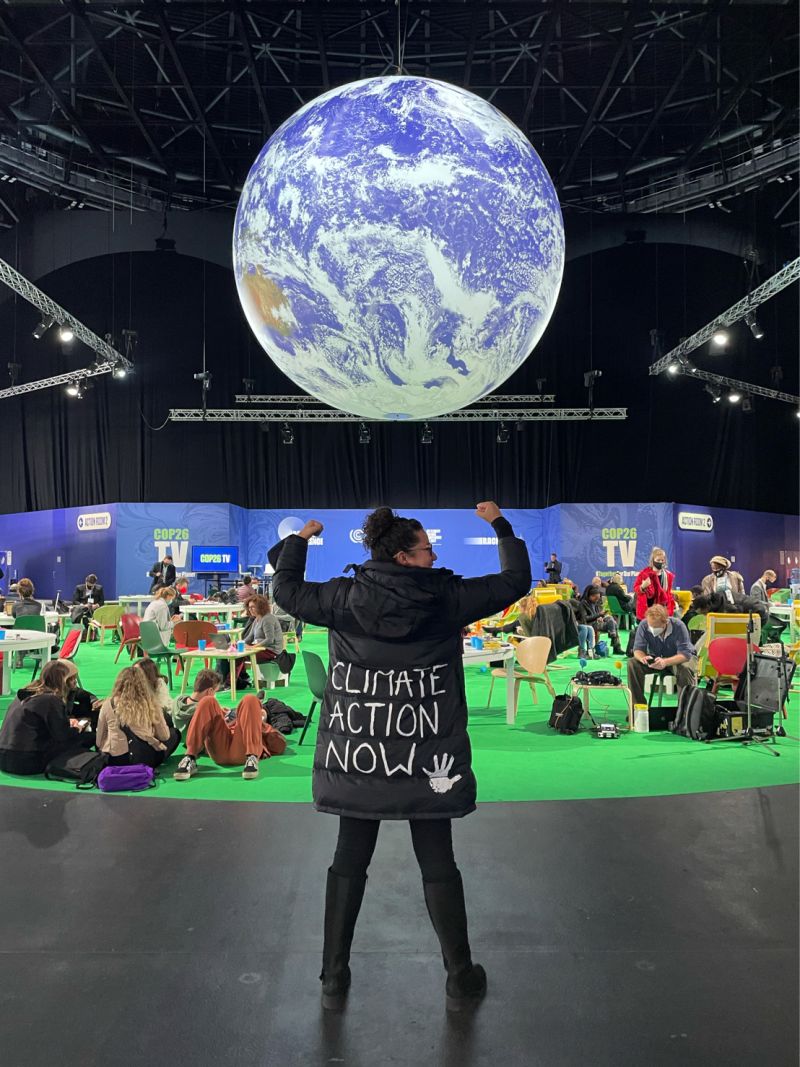This summer has been one of the hottest on record both on land and in the sea at least off the shallow waters of Florida. At the end of July, a scientific data recording buoy noted Florida’s water at 101.1 degrees Fahrenheit at the Everglades National Park. It might have been the hottest seawater temperature ever recorded. This sounded off alarms to experts, scientists and climate change activists. All exclaim this as not normal and marine life can not thrive or live in hot tub-like conditions. But hope is still on the horizon with climate change activists including Latinas in environmental justice.
The heatwave recorded in July 2023 had a significant impact on the marine species inhabiting the coral reefs. These marine ecosystems host a wide variety of animals, ranging from fish, oysters, and sea sponges to urchins and microscopic algae. When the water temperature changes from its usual temperatures, life in this environment is affected, contributing to the bleaching and eventual death of the corals, as observed earlier this summer in some of the hardiest coral formations in the Florida Keys.
Coral bleaching occurs when the microscopic algae living within the coral abandon it due to stresses like temperature or light changes. These algae, known as zooxanthellae, provide their hosts with the necessary nutrients for corals to strengthen their calcareous structure. They also lend vibrant colors to the corals, making them fascinating to observe. In return, the coral provides the algae with a place to dwell, reproduce, and safeguard themselves. Scientists call coral reefs “the rainforests of the sea” because they are so vital in sustaining the earth’s biodiversity, citing they hold 25% of all ocean marine life.
Video thumbnail: Coral bleaching process captured by National Geographic
In 2005, concentrated heat in the American Caribbean Coral Reefs caused bleaching and the death of half of coral reefs. Conversely, extremely cold water temperatures, such as those recorded in the Florida Keys in early 2010, also induced coral bleaching. That year, temperatures dropped by 6.7 degrees Celsius, equivalent to 12.06 degrees Fahrenheit, as reported by government agency the National Oceanic and Atmospheric Administration (NOAA).
NOAA is responsible for predicting and researching changes occurring in the oceans and the atmosphere. NOAA has identified a consistent increase in temperatures in the waters surrounding the state of Florida and the Gulf of Mexico during the latter half of 2023. Consequently, this is leading to unprecedented heat-related stress conditions in the marine ecosystem.
"Anytime there's a heat event, that's stressful. It's stressful to us, it's stressful to animals. The problem is corals can't move. They can't get out of the way. They can't go to cooler waters"; said Rachel Morgan, Senior Coral Biologist at the Florida Aquarium in Apollo Beach, stated to CBS News
The ocean temperature has steadily increased in recent years. In fact, when the water temperature reached 101.1 degrees Fahrenheit in the Florida Keys this past July it was alarming because the highest recorded ocean water temperature was 99.7 degrees was in Kuwait in 2020 on the open sea.
Brian McNoldy, senior research associate at the University of Miami's Rosenstiel School of Marine, Atmospheric, and Earth Science, noted that these temperatures may not be considered a global record, as they were recorded using a buoy in shallow waters, which could have been influenced by the proximity to the Everglades National Park. Despite the recordkeeping temperatures these high temperatures are detrimental to keeping coral reefs alive that produce much of the ocean’s 50% oxygen for the earth.

“Relative to temperatures recorded from 1991 to 2020, the waters surrounding South Florida are 5 to 7 degrees Fahrenheit above normal”, said McNoldy to ABC News.
Since 1975, there has been a 2,500% increase in sea temperatures, according to a NOAA research ecologist this is not normal and climate activists are leading the effort along with the scientific community for a local, state and global change to prevent the earth’s boiling point. Enter, Latina climate change guerreras.
Latinas Committed to Climate Change
Nicole Becker, Argentina
Argentinian activist Nicole Becker, 22-year-old, is an example of Latin American commitment to climate change. In February 2019, she watched a video of Greta Thunberg and other young people in Europe marching for the climate crisis. At that time, she believed that environmental issues were unrelated to human rights. However, after conducting research, she discovered that the United Nations recognized climate change as a threat to human rights.
Inspired by the European "Fridays for Future" movement, Becker joined forces with some friends and decided to create an organization that would represent them as Latin Americans and Argentinians. This is how "Jóvenes por el clima" or Youth for the Climate was born. The young people decided to participate in the First International March for the Climate Crisis, which took place on March 15, 2019. Becker didn’t know how many people would respond to their call, they organized and made the announcement. More than five thousand people attended this first mobilization, which showed them that there were indeed people interested in climate change. From that moment on, Becker and her colleagues began to engage in political issues. That same year, they succeeded in having Argentina declared a country in a climate and ecological emergency, as Becker mentioned to Vogue.
Sandra Guzmán Luna, México

Sandra Guzmán Luna is the founder of the Climate Finance Group for Latin America and the Caribbean (GFLAC). The young Mexican earned a Ph.D. in policy from the University of York in the United Kingdom and has worked on a topic that many Latin American countries still don't have clarity on like how much money does Latin America and the Caribbean need to prepare for climate change?
The organization has developed a tool that allows them to determine how much each country invests in policies to reduce greenhouse gas emissions into the atmosphere. This has enabled them to estimate that the leading climate change emitters in Latin America will need approximately $25 billion to meet the goals of the Paris Agreement.
At a time when global warming is a reality, activists from various generations are raising their voices to call on world leaders. Latin America is not exempt from this responsibility and call to action.
Vanessa Hauc, Peru/United States
Vanessa Hauc is an Emmy Award-winning Peruvian journalist who uses her platform to educate people on environmental issues such as climate change. As an environmental reporter, she started a five minute segment called Alerta Verde (or “Green Alert'') on Telemundo to share stories about environmental issues. She is also the co-founder of Sachamama, a nonprofit organization that works to educate and empower the Latinx community on climate issues and maintain sustainable attitudes, behaviors and lifestyles
Figures like Nicole Becker, Sandra Guzmán and Vanessa Hauc have taken the matter into their own hands and have decided to confront the climate situation, demonstrating that the time for change is now. If global warming is not taken seriously, future generations may not have a future.
The oceans are experiencing climate change.
Oceans play a crucial role in mitigating climate change by serving as natural reservoirs of heat and carbon. According to the World Bank, oceans absorb 90% of the excess heat generated by climate change and store 23% of the carbon dioxide (CO2) emissions produced by human activity.
In the United States, greenhouse gas emissions are primarily attributed to five key sectors: transportation, electricity generation, industry, commercial activities, and agriculture.
According to data collected by the Environmental Protection Agency (EPA) in 2021, the transportation sector was responsible for emitting 28% of the greenhouse gasses produced by the United States. The second-largest contributor was electricity generation, accounting for 25% of CO2 emissions. In third place was the industry sector, which, in addition to consuming large amounts of energy, is also responsible for using chemicals that contribute to climate change. The fourth position was occupied by various commercial and residential activities, representing 13% of the emissions reported in that year. Specifically, it pointed to the use of fossil fuels in services related to heating, lighting, cooling, and waste management. Finally, the agricultural and livestock sector emitted 10% of these gasses. However, this sector also includes forestry, responsible for the cultivation and maintenance of forests, which offset 12 % of emissions in 2021. Furthermore, since 1990, it has absorbed more CO2 than it emits in the United States.
From Global Warming to the Era of Global Boiling
Despite the La Niña phenomenon providing a slight respite in the temperature increase, the years from 2015 to 2022 have seen the eight warmest years in the past 173 years. Additionally, the El Niño effect has begun, implying that one of the next five years is likely to be much hotter. This was noted by Chris Hewitt, Head of International Climate Services at the World Meteorological Organization (WMO).
Following a period of high temperatures in various parts of the world in July, the UN’s Secretary-General António Guterres has declared that the era of global warming has concluded, and we have now entered the era of global boiling. During a press conference, the Secretary-General called on world leaders to take action and set aside the excuses that hinder necessary changes.
“It's a cruel summer for the entire planet it is a disaster and for scientists it is unequivocal humans are to blame all this is entirely consistent with predictions and repeated warnings the only surprise is the speed of the change; climate change is here, it is terrifying and it is just the beginning. The Era of global warming has ended and the era of global boiling has arrived” said Guterres at a UN press briefing.
Still hope lies in the power of change. The UN Secretary-General also mentioned that it is still possible to come together to limit the global temperature increase to 1.5 degrees Celsius and avert the worst effects of climate change. However, achieving this goal requires swift and responsible actions. He along with the Latina climate change activists guererras continue to call on leaders especially of G20 member countries who are responsible for 80% of greenhouse gas emissions, to commit to reaching net-zero emissions as close to 2040 as possible.






